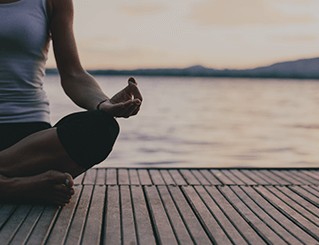Manage joint pain by taking your walking routine to the pool.
Looking for a great summer workout? Leave your gym shoes in the closet and turn to water exercises instead. Swimming and walking is becoming increasingly popular, with classes popping up across the country – and for good reason, says Vennie Jones, aquatic coordinator for the Baylor Tom Landry Fitness Center in Dallas.
Like all water exercises, water walking is easy on the joints. “The water’s buoyancy supports the body’s weight, which reduces stress on the joints and minimizes pain,” says Jones. “And it’s still a great workout. Water provides 12 times the resistance of air, so as you walk, you’re really strengthening and building muscle.” You do not bear weight while swimming and walking, however, so you’ll still need to add some bone-building workouts to your routine.
“A lot of clients I see tell me a warm pool is heavenly,” says Lori Sherlock, an assistant professor in West Virginia University’s department of exercise physiology. Physicians and physiologists have warmed to the idea of water walking as therapy and good exercise for people with joint pain and damage for its many benefits, which include:
- Water’s buoyancy reduces the impact on joints.
- Working out in water can help improve cardiovascular fitness, balance, and range of motion.
- Heated pools – typically 82 to 88 degrees – can help soothe pain. Cooler temps might not make your joints feels as good, but you’ll still reap the workout’s benefits.
- Water also has greater resistance than air, which means walking in water requires more effort and ultimately burns more calories than walking on land.
Many aquatic centers, YMCAs and community pools have programs designed for people with arthritis. Classes typically fall into three categories: Interval classes combine periods of walking and periods of rest; continuous training classes have participants walk at 70 to 75 percent effort level throughout the workout; and station classes combine flexibility or strength exercises with walking workouts.
"Many aquatic centers, YMCAs and community pools have programs designed for people with arthritis."
Classes take place in water at chest level or in deep water, where participants have no contact with the pool’s floor and are supported by flotation vests. Deep-water classes are usually more intense and can benefit people with severe pain and joint damage, says Sherlock. These classes take away the impact of gravity and allow joints optimal flexing, which can improve range of motion.
If you are new to exercise or can’t swim, don’t worry. Aquatic walking classes are designed for anyone, including non-swimmers. And if you fall in love with swimming and walking, you can keep going in cooler months – just switch to an indoor heated pool, which can be soothing to joints.
What you need: For deep-water walking, a flotation belt keeps you upright and floating at about shoulder height.
How it works: You’ll stand about waist- to chest-deep in water, unless you’re deep-water walking. You walk through the water the same way you would on the ground. Try walking backward and sideways to tone other muscles.
Try it: Stand upright, with shoulders back, chest lifted and arms bent slightly at your sides. Slowly stride forward, placing your whole foot on the bottom of the pool (instead of just your tiptoes), with your heel coming down first, then the ball of your foot. Avoid straining your back by keeping your core (stomach and back) muscles engaged as you walk.
Add intensity: Lifting your knees higher helps boost your workout.
Find a class: If you’re new to water exercises, an instructor can make sure your form is correct. Plus, it can be fun to walk with others. To find a class near you, call your local YMCA, fitness center or Arthritis Foundation office.
Stay safe: By exercising in a pool during the hot months, you’ll avoid problems that can accompany other outdoor summer workouts, such as heat exhaustion and dehydration. But you still need to drink water—even while keeping cool in the pool.
By getting your feet wet, you could be on your way to walking with greater comfort.
*Be sure to check with your healthcare professional to see if these physical activities are right for you.
Article from Arthritis Today, the consumer health magazine published by the Arthritis Foundation. Copyright ©2018 Arthritis Foundation. All Rights Reserved. For more information on this topic visit www.arthritis.org.









